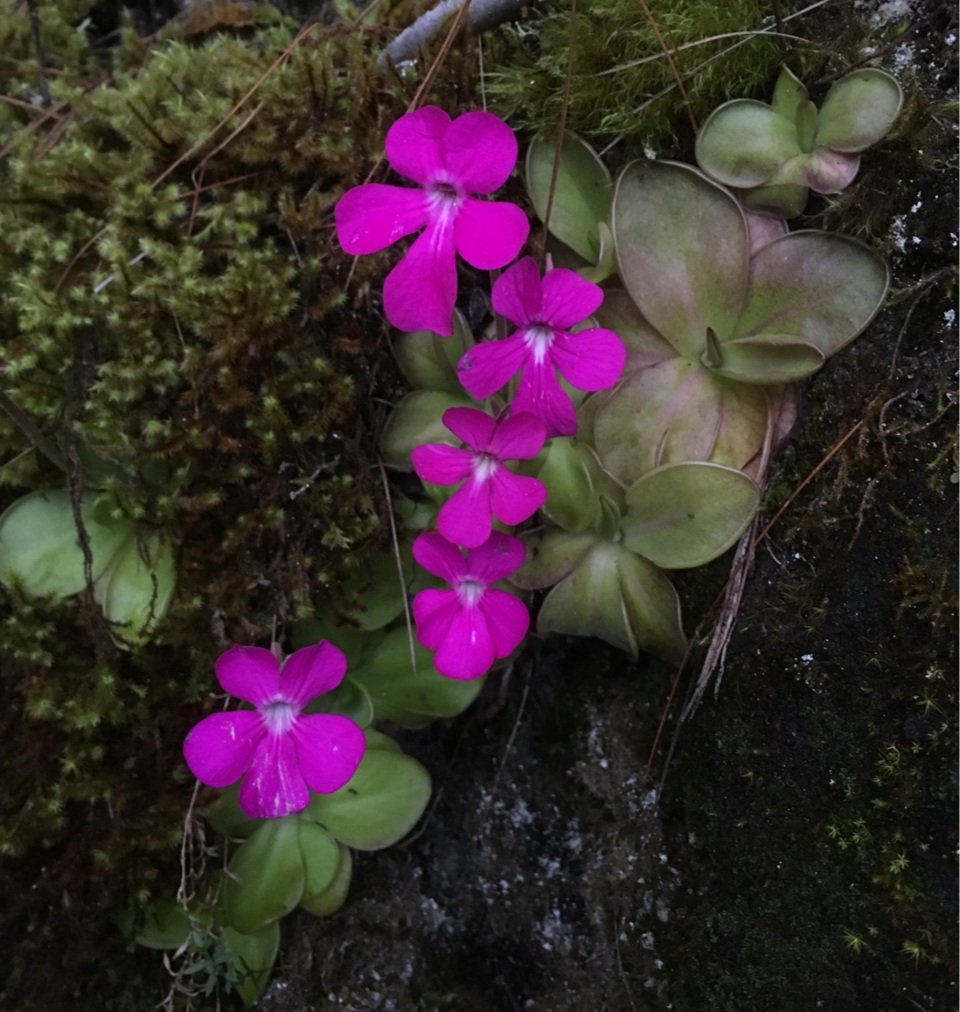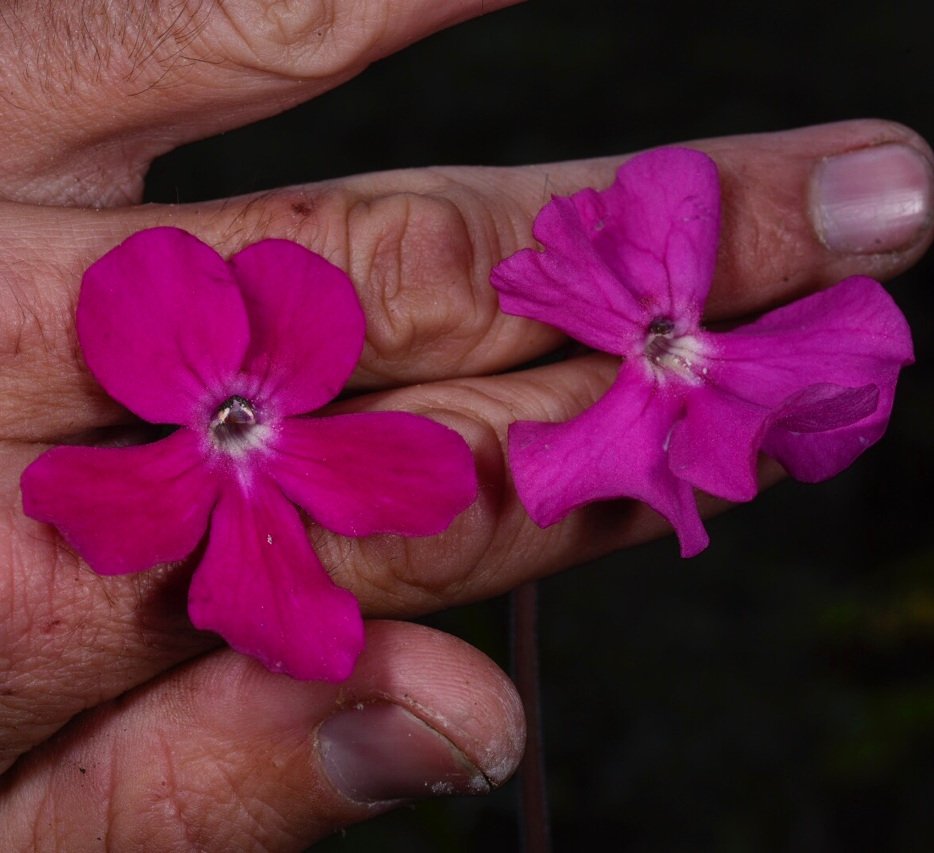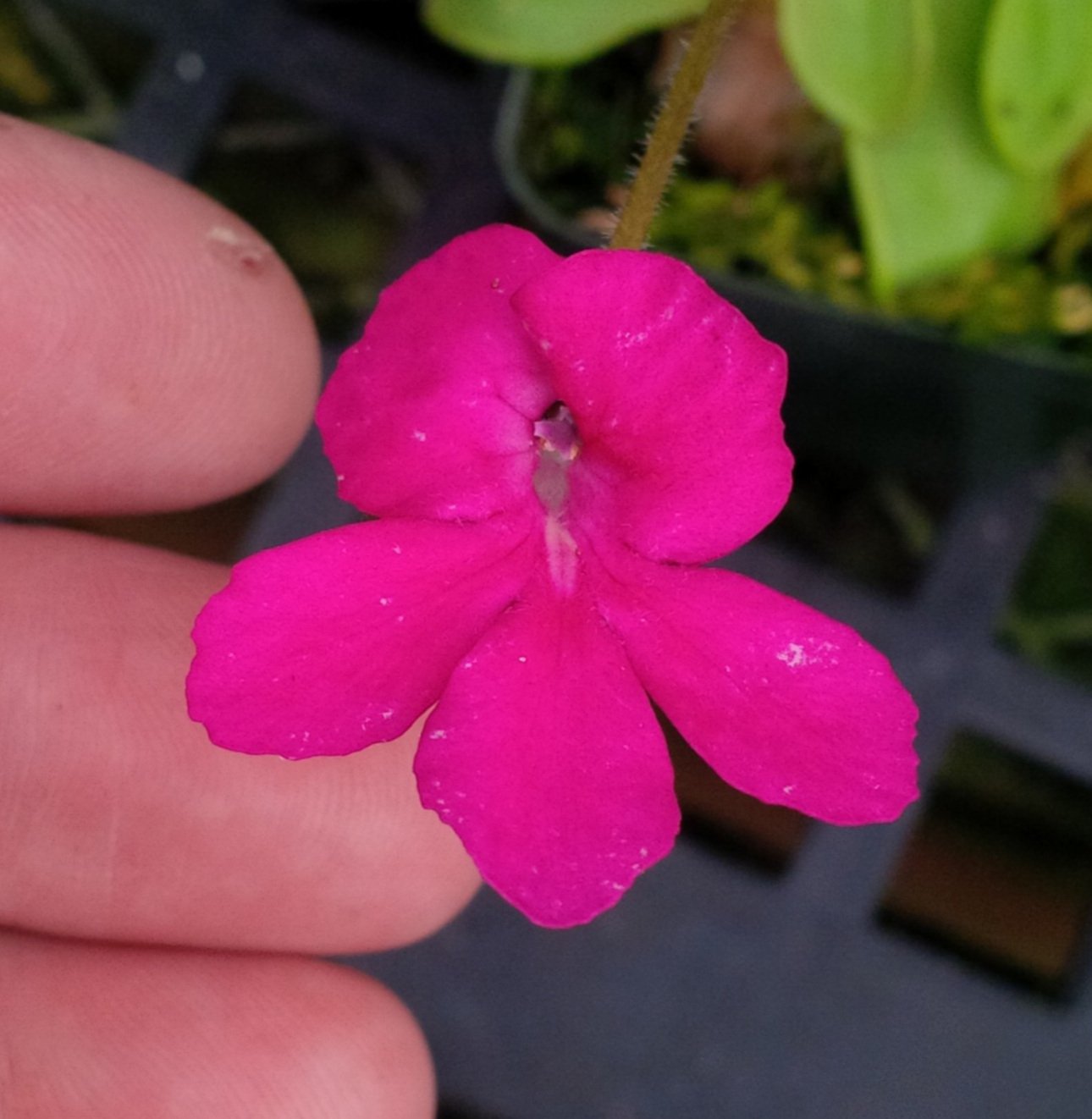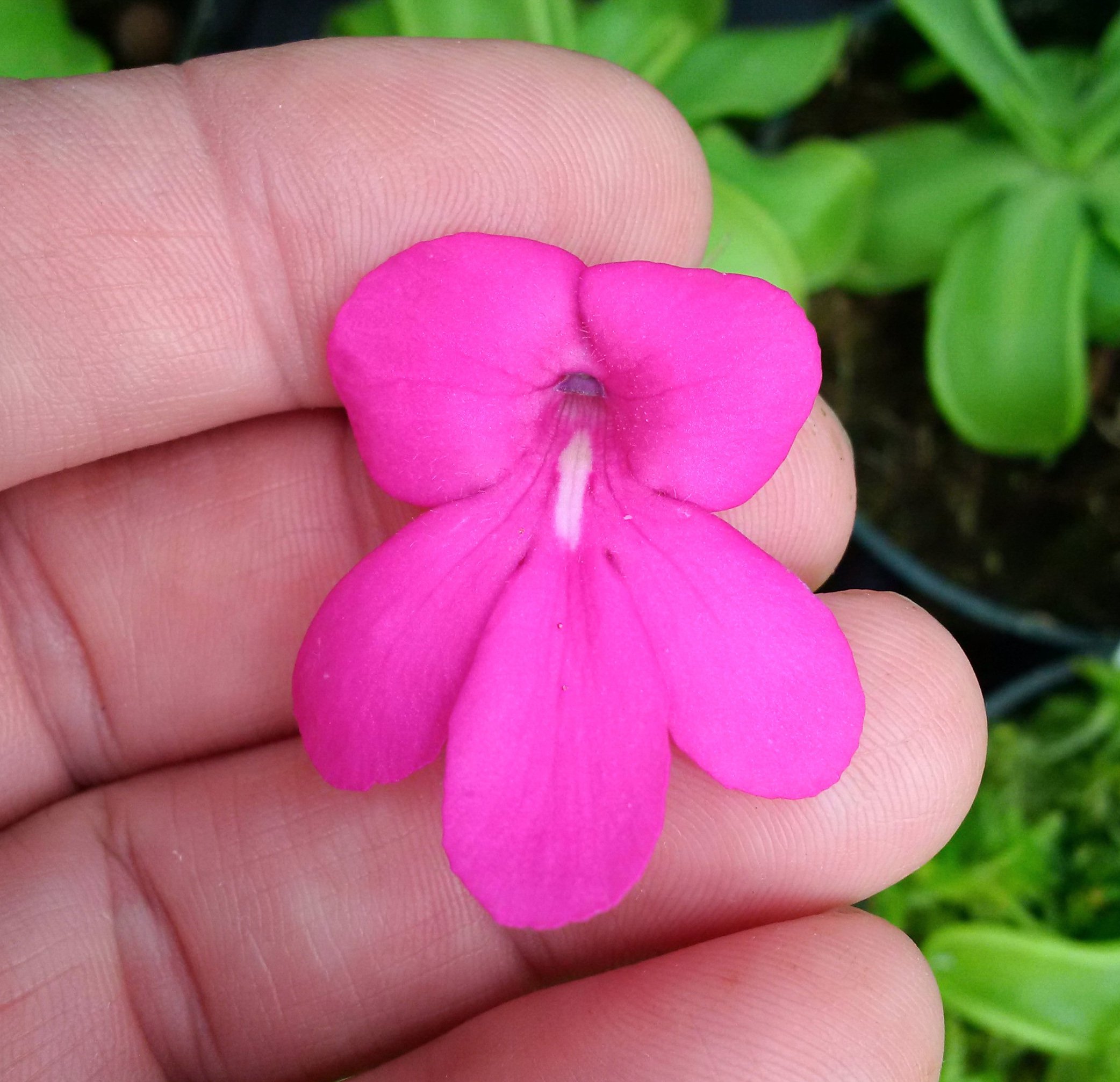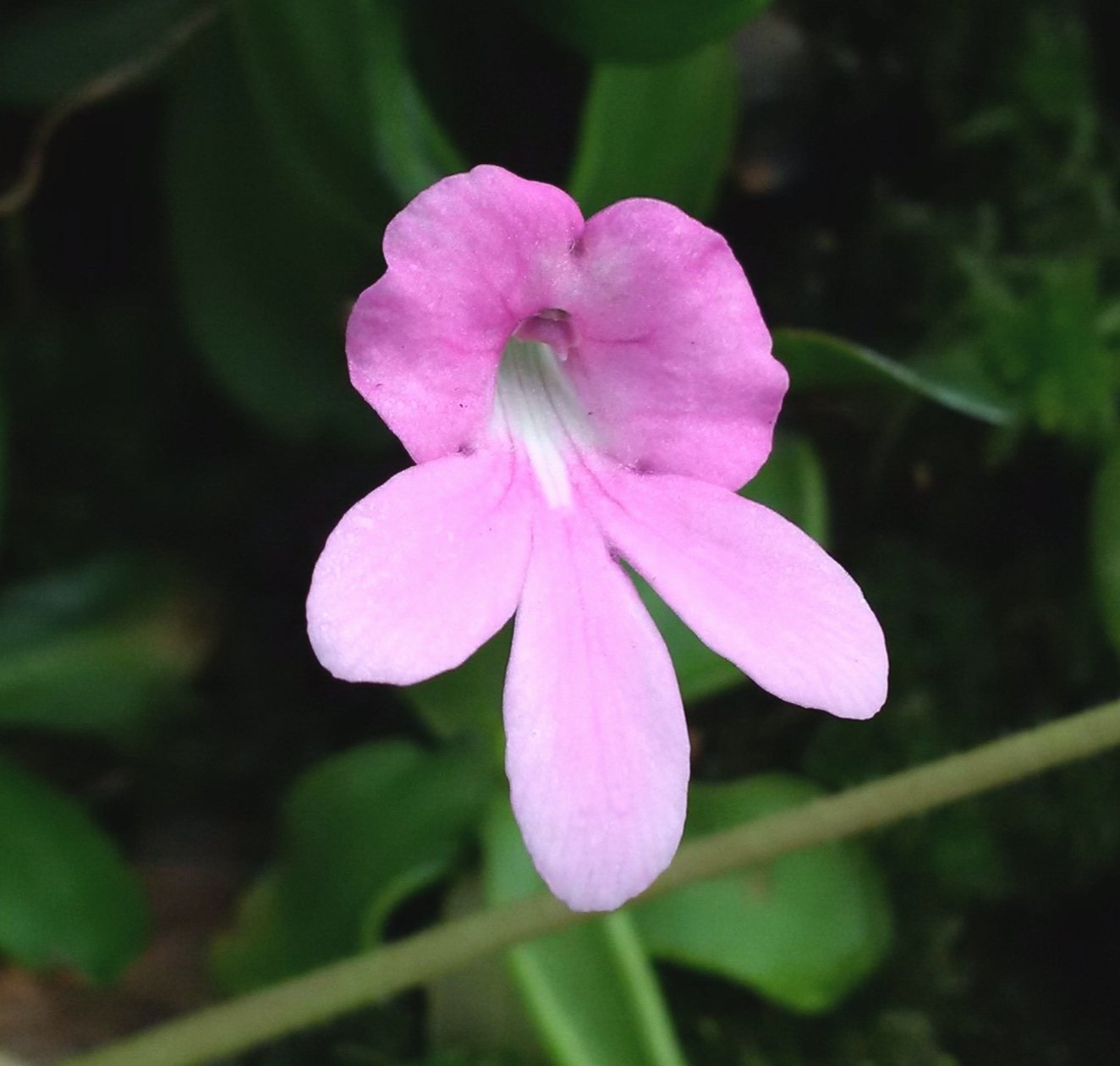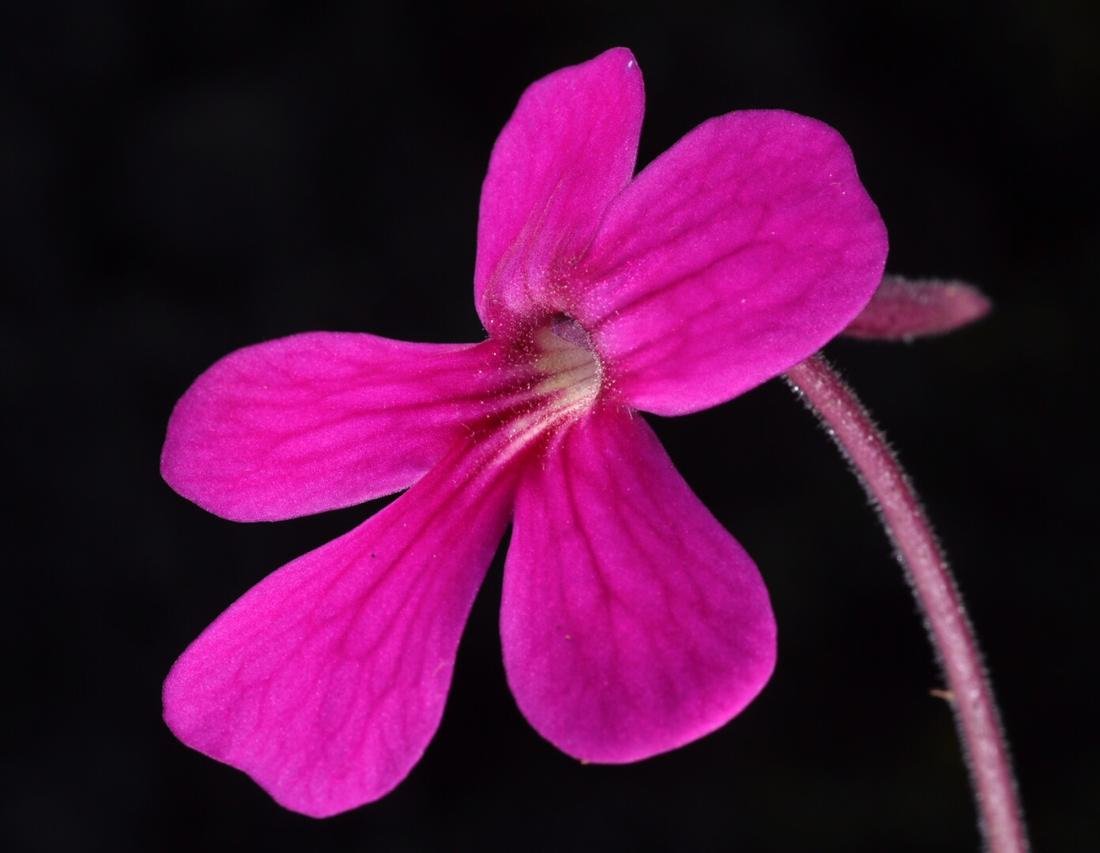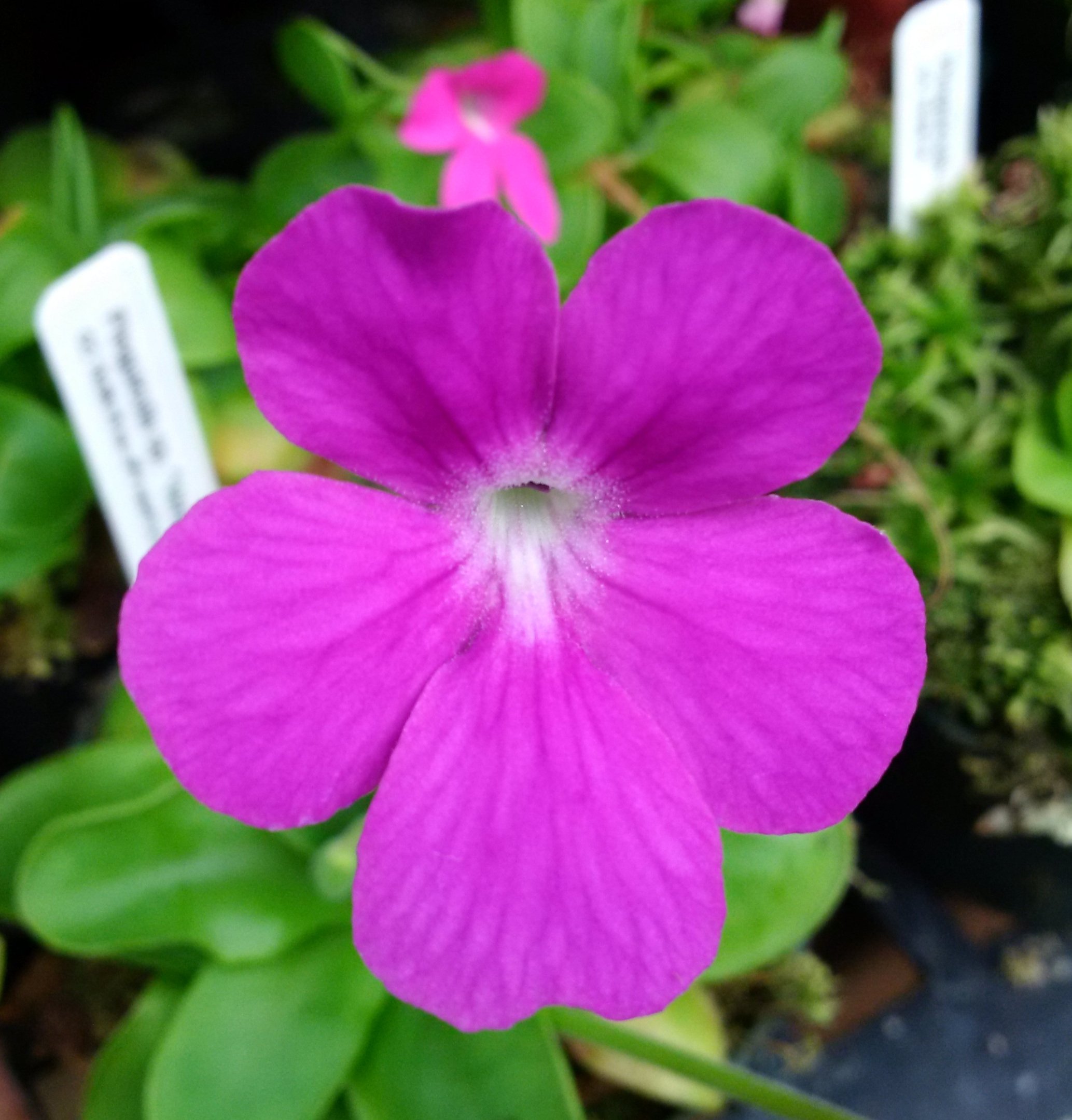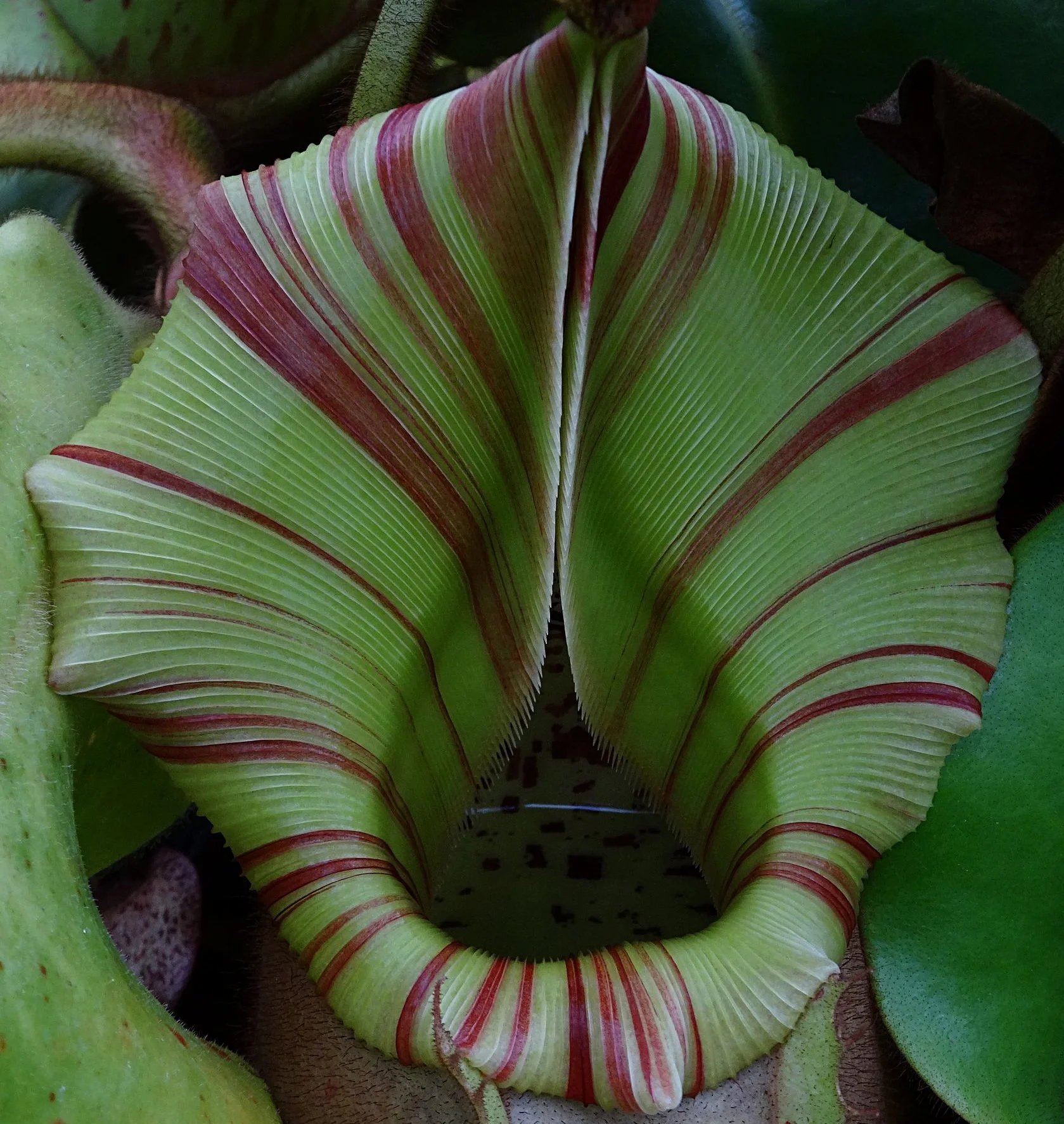Pinguicula mesophytica - Purple Rainforest
by Jay Vannini
One of my cloud forest greenhouse bench sections showing a tapestry of seed-grown, flowering Pinguicula mesophytica in both plastic pots and terra cotta bowls, together with a few red-flowered P. laueana, P. cyclosecta and P. moranensis f. semialba. Image: R. Parsons.
One of the more recent and attractive carnivorous plant introductions is the spectacular-flowered northwestern Central American orchid butterwort, Pinguicula mesophytica. Although plants masquerading under this name were marketed from plant tissue culture (PTC) introductions dating from 2006 onwards, the true species did not make it to EU and U.S. ornamental plant markets on a commercial basis until about 2013 in the Czech Republic (from PTC) and 2016 in the U.S (from seed).
This is one of the largest-flowered butterworts and is noteworthy for its almost unique epiphytic lifestyle and unmistakable in life due to its vividly-colored corollas with distinctive Mickey Mouse ear upper, and spatulate lower, lobes.
A colony of Salvadoran Pinguicula mesophytica growing at the base of a tree in high elevation mossy forest. Image: F. Muller.
Plant illustration from Zamudio’s description of Pinguicula mesophytica. The author of this paper was not familiar with living plants when the description was published. Note the partially fused Mickey Mouse ear corolla lobes shown.
Pinguicula mesophytica was first discovered and collected in southeastern Guatemala in 1939 by Dr. Julian Steyermark on Cerro Brujo in Chiquimula Department, immediately adjacent to the border with El Salvador. It was described from type material collected in 1963 by Molina and Molina on Volcan Montecristo, Santa Ana Department, El Salvador (#12601) by Mexican Pinguicula specialist, Dr. Sergio Zamudio in 1997. The first images of this species in nature were posted on the internet almost two decades ago by Dr. Oliver Komar, a U.S. ornithologist who conducted field research in 1999 onwards in Montecristo NP and published on its avifauna in 2002. These multiples images of P. mesophytica flowering as an epiphyte on the upper slopes of Montecristo National Park took the carnivorous plant collecting community by storm.
Hundreds of Pinguicula mesophytica growing in the upper canopy, adpressed to cloud forest emergent trees at high elevation. Image: F. Muller.
I spent time on Cerro Brujo area of the Volcan Montecristo complex in 1975 working with bromeliads, then again in 2002 looking for Pinguicula mesophytica but was unable to find it in Guatemala. The Cerro Brujo locality is now partially deforested, but as of about a decade ago there were still patches of primary forest remaining near the summit on the Guatemalan side of the border. The few lithophytic pinguiculas that I have seen further to the east at high elevations at Miramundo, Jalapa Department are standard-issue P. moranensis, and they are apparently absent from Volcán Ipala in Jutiapa Department, so the Cerro Brujo population seems to be as far west as P. mesophytica originally occurred.
The Trifinio Biosphere upper elevation cloud forest block at the tri-border junction on the Pacific slope of northern Central America. Image: F. Muller.
It appears to be mostly restricted to the middle and upper forested parts of the Trifinio Biosphere Reserve or tri-border area where Guatemala, El Salvador and Honduras meet. It is recorded at elevations of 4,500-7,800’/1,400-2,400 m but appears to be most common at the upper end of this range. It also is known from slightly east of the Montecristo volcanic massif at high elevations in southwestern Honduras. It grows in nature primarily as an epiphyte, both adpressed to emergent tree trunks and on attached climbers, as a lithophyte and occasionally as a terrestrial beneath epiphytic populations. Based on flower morphology, its closest relative is thought by some to be Pinguicula colimensis, a highly-specialized, heterophyllous, low elevation west Mexican calciphile that is also a Pacific slope butterwort species. The separation of these two species by almost 1,000 miles/1,600 km and >3,250’/1,000 m in elevational range suggests that they are not particularly closely related, despite opinions to the contrary (Lampard, et. al. 2016). It seems far more likely that P. mesophytica is part of a small group of currently undescribed regional taxa that share overlapping upper corolla lobes, reddish-purple flowers, and an epiphytic or lithophytic habit.
This species has unique leaves for a regional Pinguicula species in being markedly spatulate in shape, often with upcurved or incurved margins. This is a feature shared with other Mesoamerican forms growing further to the northwest, which appear to function as raindrop traps. Another unusual but very desirable feature of this species in cultivation is that groups of plants may be in flower almost year-round, although they usually take a break in my California collection from late December through early March. If kept slightly moist or in a high humidity environment during fall and winter my experience is that while it is moderately heterophyllous, it will not exhibit true dormancy unless extremely moisture stressed. Rosette diameters can be as to >5.5”/14 cm in summer on exceptionally robust plants but are usually <4”/10 cm across when fully expanded. Outside of the U.S. and the EU, plants originating from both Salvadoran and Honduran populations are in limited cultivation in Guatemala, El Salvador, México and Asia.
Above images show a very striking lithophytic Pinguicula sp. at very high elevation glaciated habitat in western Guatemala. Note the degree of variation between corolla shapes of plants growing side-by-side. Flowers on plants from this population are known for their very large size, vibrant colors and marked tendency to overlap or fuse their upper corolla lobes (see flower shown above extreme right). Images: F. Muller.
Several Mesoamerican Pinguicula species have been reported to occur as epiphytes, either on a regular basis as in the Oaxacan cloud forest P. hemiepiphytica, or opportunistically like some P. moranensis ecotypes.
Three color shades of Pinguicula mesophytica that I grow in California. Besides these variants, some flowers show distinct “splash” contrast coloring on the corollas. Flowers are surprisingly long-lasting in this species when temperatures are moderate and relative humidity is high.
Pinguicula mesophytica plantlets growing from seed sown in vitro.
A nicely-flowered 6”/15 cm terra cotta bowl planted with typical-colored Pinguicula mesophytica.
I currently cultivate over 60 seed-grown clones of Pinguicula mesophytica, originally of high elevation Honduran origin. Some of these plants were colchicine-treated in the lab that sowed them in vitro in an attempt to induce polyploidy. Corolla colors among the clones are mostly a uniform fluorescent magenta, with some individuals having light pink, very pale reddish-purple and “splash-petaled” flowers. While originally described as having red flowers that are smaller than P. moranensis (Zamudio 1997), both statements are in error. Flowers on both artificially-propagated and wild origin plants to ~1.5”/3.8 cm in length across the corolla lobes and are largest in mid-summer. They are fairly long-lasting, but at their most intense in the first five days following their opening. No white-flowered forms seen by me so far, but further breeding will probably produce some over time. Although I am not engaged in hybridizing them myself, I’m sure as more of this seed-grown material reaches other CP growers’ hands, crosses with other showy-flowered pinguiculas will be made.
There is a bit of “inside baseball”-type minor controversy that clings to this species. The confusion surrounding the misidentified material labeled Pinguicula mesophytica that circulated for almost a decade in PTC originates from artificially-propagated seed that I provided in spring 2003 from central Guatemalan cloud forest origin epiphytic P. cf. moranensis. This population had been tentatively identified from photos as P. mesophytica by an eminent German Pinguicula specialist I corresponded with at the time. I hand-pollinated the flowers that produced the seed in question and would note that there were no other pinguiculas in flower in my collection during that period. This seed was gifted to a well-known French butterwort enthusiast who, unbeknownst to me, forwarded it to at least one commercial PTC lab where it appears that it was accidentally (?) substituted for hybrid material of unknown provenance. The resulting propagations were subsequently released by EU-based nurseries as P. mesophytica. While images here show that some of the epiphytic and lithophytic Baja Verapaz P. cf. moranensis superficially resemble P. mesophytica (but usually lack the diagnostic overlapped upper corolla lobes), the PTC plants do not. Indeed, I am more than just a bit surprised that the hybrid origin of these plants was not evident to nurseries that sold it from the moment that they first flowered. I was still able to purchase a plant from a nursery labeled as P. mesophytica from a U.S. CP nursery in early 2017 (shown here) and some growers are apparently still convinced that this hybrid is the true species. Such are the powers of self-delusion. The negative commercial fallout from this case of mistaken identity is that, until very recently, there has been far less interest than expected in line-bred P. mesophytica plants of known provenance by growers. This is no doubt due to bad press the hybrids got on CP online discussion boards and the generally poor quality of EU plants out of PTC that many CP growers soured on the name.
Above left, an image of a wild, epiphytic Pinguicula moranensis from Baja Verapaz. This population was briefly confused with P. mesophytica by a European CP specialist almost two decades ago. Note color similarity to some P. mesophytica shown here. Image: F. Muller. Right, a flower of the plant from PTC that circulated for a decade in the nursery trade as P. mesophytica. Neither, obviously, are the real deal. Image by the author.
This is a surprisingly easily maintained carnivorous plant in cultivation. I grow these plants mounted on cork and live Hylocomium sp. and Ptilium crista-castrensis mosses or potted in pure New Zealand AAA sphagnum moss. Others are now growing them in mineral substrates suitable for tropical butterworts, reportedly with some success. While they can tolerate brief periods of high daytime temperatures (~95 F/35 C) if humidity is high, they generally prefer a temperature range of 50 to 80 degrees F/10-27 C.
This is, obviously, the best butterwort for mixed, cool tropical vertical and wet wall plantings since it does not require any type of “hard” dry dormancy that might impact other plants grown with it that require irrigation year-round. The images shown above of hundreds of wild and cultivated flowers en masse suggest it would make a bold visual statement as a display in a public garden.
A tabletop display of mine staged in a large bonsai pot showcasing Pinguicula mesophytica and exhibited at the 2018 San Francisco Orchid Society’s summer show, “Orchids in the Park”. Among carnivorous plants, this species is unmatched as a subject for wet-wall/vertical gardens.
I have provided a step-by-step tutorial on a tabletop type vertical display that I assembled to showcase this species elsewhere on the website, that may be viewed by clicking here.
More thanks again to Fred Muller for his generosity sharing excellent images of wild pinguiculas and considerable knowledge of this species in habitats across its known range. Dr. Robert Hamilton sowed and treated seed in his lab for me as a great personal favor. Dr. Sergio Zamudio kindly provided me with reprints of his descriptions of regional pinguiculas, including Pinguicula mesophytica, during our very interesting correspondence about 15 years ago. Well known Bay Area plant photographer Ron Parsons, who is definitely a fan of this species, provided the striking panoramic shot of almost a hundred of these plants flowering along one of my greenhouse benches during the summer of 2017 and shown above.
Plants are available for sale. Please use contact information provided on main page.
Uncommon hot pink flower color form of Pinguicula mesophytica grown by the author in California.
All content ©Exotica Esoterica LLC® 2019-2025, ©Jay Vannini 2019, ©Fred Muller 2019 and ©Ron Parsons 2019
Follow us on:

